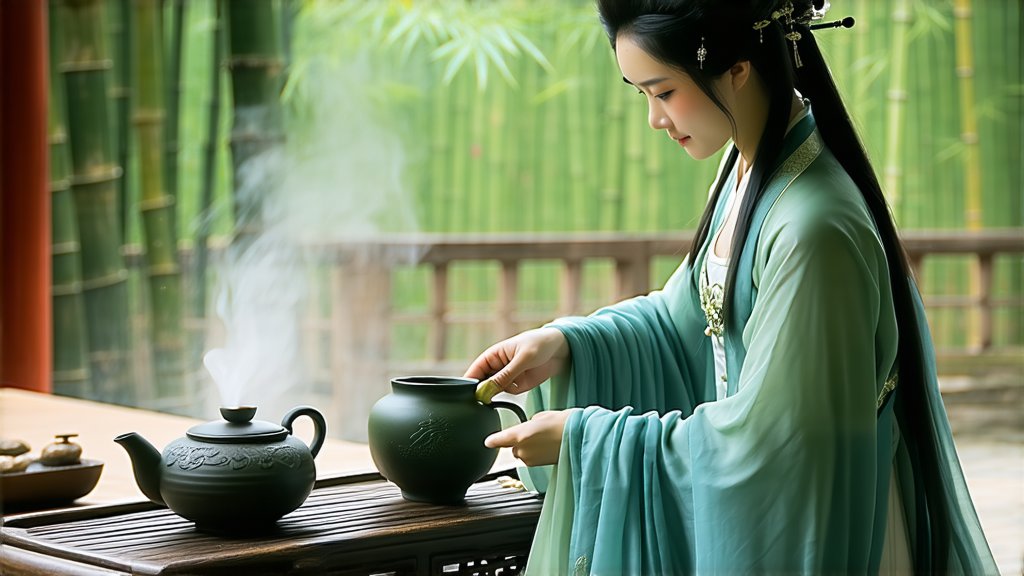
In the lush landscapes of Fujian Province, nestled within the heartland of China's tea culture, lies a gem that has captivated connoisseurs and casual drinkers alike for centuries – Tieguanyin. Often referred to as the "Iron Goddess of Mercy," this exquisite oolong tea is more than just a beverage; it embodies an art form, a tradition, and a testament to the intricate relationship between man and nature.
Historical Background
The origins of Tieguanyin can be traced back to the early Qing Dynasty (1644-1912), with its name believed to be inspired by a Buddhist statue of Guanyin, the Goddess of Mercy, found near the initial tea bushes. Legend has it that these tea plants were discovered by a poor scholar named Wei Yin who, after being saved from starvation by a mysterious woman who revealed herself to be Guanyin in disguise, vowed to honor her by naming his discovery after her. Thus, "Tieguanyin" was born, symbolizing both gratitude and divine intervention.
Varieties and Characteristics
Tieguanyin falls under the category of oolong teas, which are semi-oxidized and partially fermented, striking a balance between the freshness of green teas and the richness of black teas. It is renowned for its tightly rolled, ball-shaped leaves that unfurl gracefully when brewed, revealing emerald green hues interspersed with hints of red. The aroma is a complex medley of floral notes—orchid, magnolia, and sometimes even creamy vanilla—that dance on the palate alongside a sweet, buttery flavor profile. What sets Tieguanyin apart is its unique "觀音韻" or "Guanyin rhyme," a subtle yet distinct quality that leaves a lasting impression on the taster.
The Art of Crafting Tieguanyin
The meticulous process of creating Tieguanyin involves several stages: sun wilting, cooling, fixing, rolling, drying, and roasting. Harvest typically occurs multiple times a year, but spring yields the most prized leaves due to their tenderness and high concentration of amino acids, contributing to the tea's delicate sweetness. After picking, the leaves undergo a series of meticulous hand manipulations to shape them into their characteristic orb-like form, ensuring optimal flavor extraction during brewing.
Roasting is a critical step that further refines the tea's character. Light roasting preserves the tea's natural fragrance and bright flavors, while medium to heavy roasting imparts deeper, toastier nuances. Master tea makers skillfully navigate this spectrum to create variations tailored to different tastes and preferences.
Appreciating Tieguanyin: The Gongfu Tea Ceremony
To truly appreciate Tieguanyin, one must engage in the ancient practice of Gongfu tea ceremony, a ritualistic preparation method that emphasizes precision, mindfulness, and respect for the tea. This ceremony typically involves a small clay teapot (Yixing) and matching cups, allowing for precise control over water temperature and steeping time.
Begin by rinsing the leaves gently with hot water around 95°C (203°F) to awaken their flavors. Discard this initial rinse. For subsequent infusions, follow a sequence where brief steeping times (around 15-30 seconds) gradually increase, coaxing out layer upon layer of complexity from the leaves. Each brew reveals new facets of aroma and taste, making Tieguanyin a journey rather than a destination.
Observing the unfurling leaves in the pot, noticing the shifting hues of the liquid, and inhaling the evolving scents are integral parts of the experience. Sip slowly, savoring the interplay between astringency and sweetness, and let the tea transport you to the misty mountains of Anxi where it all began.
Conclusion
Tieguanyin stands as a testament to China's profound tea heritage, encapsulating centuries of history, craftsmanship, and cultural significance within each delicate leaf. Its allure lies not only in its exceptional taste but also in the stories it whispers and the traditions it upholds. As you embark on your own exploration of this Iron Goddess, whether through a solitary cup or shared among friends, it becomes clear that Tieguanyin is more than just a tea—it is an invitation to connect with a legacy that spans generations and transcends borders.